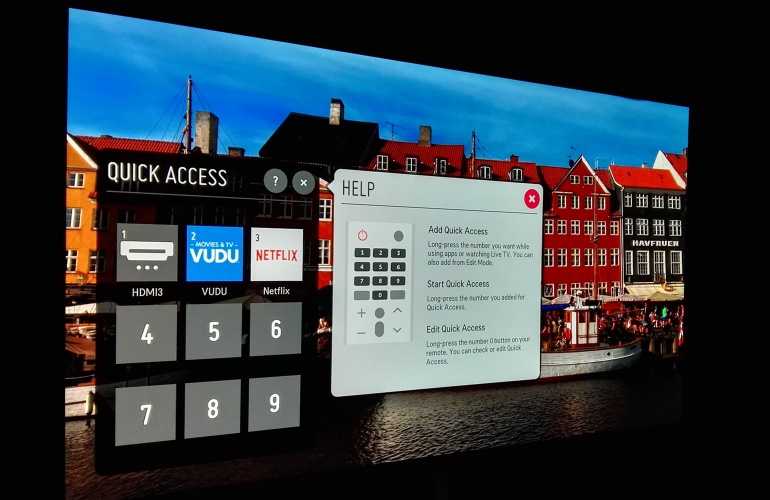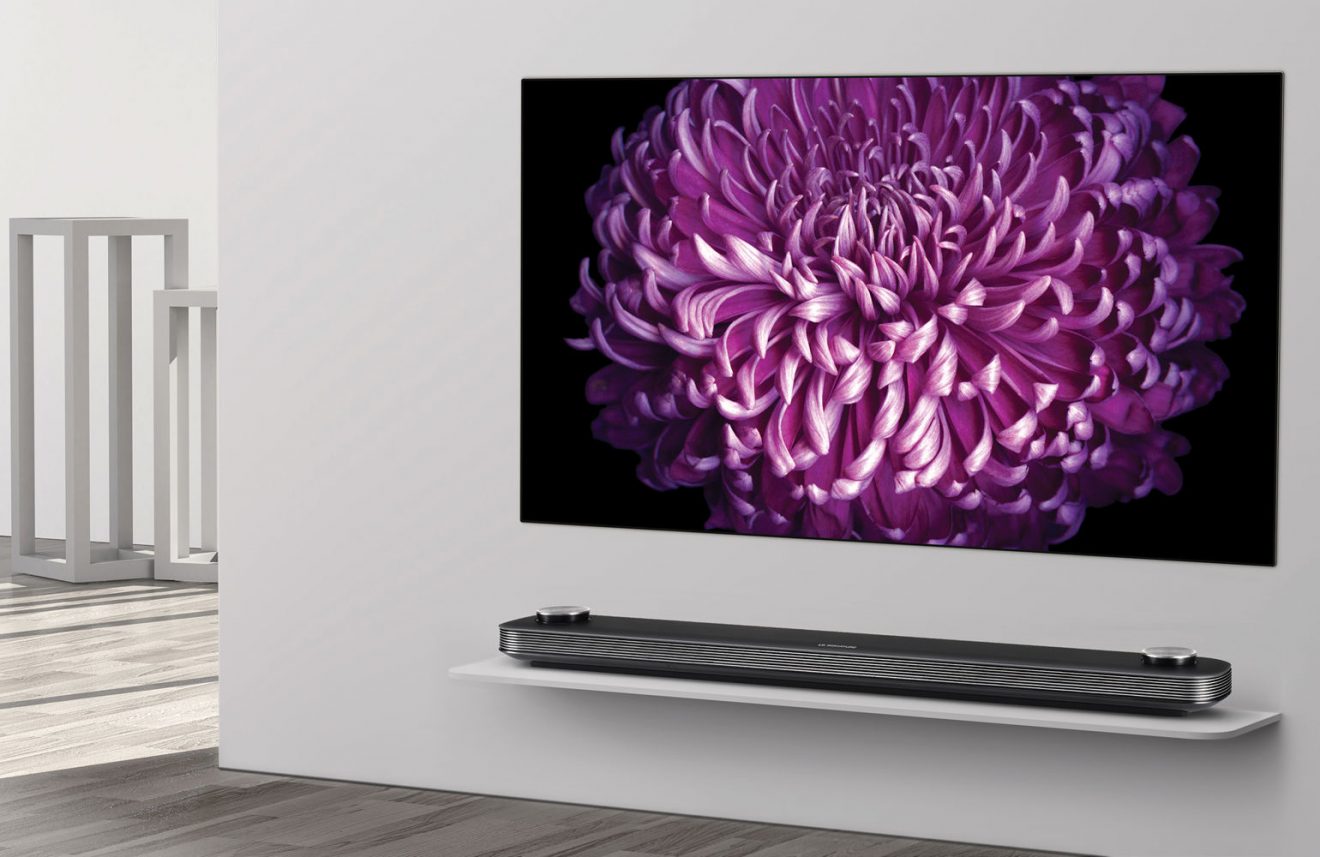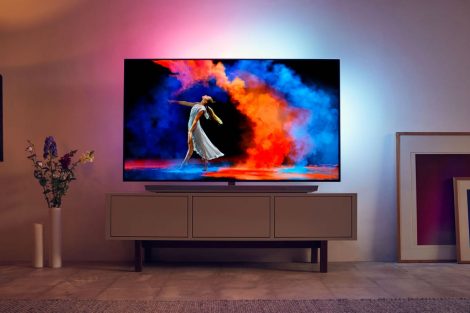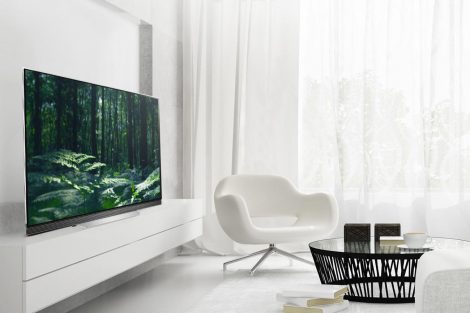We have been talking about it for years: a television that is so thin that it looks like an image is hanging on the wall. We have known that this is possible with OLED for some time, but it remains a surprise to see it finally realized. The LG Signature OLED65W7V is LG’s new top model for 2017, and it is very appropriately named Wallpaper OLED TV. In this article you can read our review.
LG OLED65W7V – specifications
What: Ultra HD OLED TV, Picture on Wall design
Screen size: 65 inches (139 cm), flat
Connections: Soundbar: 4x HDMI (1xARC 4x v2.0a), 1x optical digital out, 3x USB (1x 3.0), 1x digital optical audio out, 3x antenna
Extras: HDR10, Dolby Vision, HLG, WiFi (802.11ac) built-in, WebOS 3.5, USB / DLNA media player, DVB-T2 / C / S2, CI + lock, Magic Premium Remote, voice control, Dolby Atmos Soundbar,
Dimensions: nnb x nnb x nnb mm (incl foot)
Weight: nnb kg (incl foot)
Consumption: nnb / nnb watt (Energy label nnb)
Recommended retail price: 7.999 euro (presumably)
LG OLED65W7V – design
As soon as you reduce a television to just a three mm thin screen, there is of course still little to tell about the design you would think. On the contrary, we are now seeing for the first time the advantages and disadvantages of such a design. The LG OLED65W7V looks fantastic on the wall. The wall bracket is no more than a large flat plate, with two small buttons in the upper corners. You let the TV slide from top to bottom over those buttons, so that they reach into the two recesses on the screen. Magnets do the rest of the work and keep the screen nicely in place. Around the image is still a black border of a small cm, but that’s it. Pure image on the wall!

But of course you also need to have sound. For this, LG has equipped the television with a separate soundbar, which is connected to the screen via a flat ribbon cable. It not only provides images, but also provides the necessary power supply. It is therefore the only cable that you have to provide. It is approximately 27mm wide, and you get two cables (one of 47cm and one of 150cm) that you can possibly link together up to a maximum length of 197cm.

The soundbar itself is a striking appearance, especially with the two upfiring loudspeakers that come up when you turn on the television. The most important limitation of the entire set-up: you have to provide a shelf, or better still a layer of furniture to set up the soundbar. After all, you can not mount the soundbar on the wall. Moreover, you also have to take into account all the devices that you want to connect to the soundbar and which also have to be given a place somewhere. To minimize the aesthetics of the screen, you want to keep everything out of sight. That is why LG had better opt for a soundbar that you can also mount on the wall. In combination with a separate box that contains all connections (as shown by Samsung this year) that would provide much more flexibility.
Connections
As mentioned above, all connections are on the soundbar. You will find four HDMI connections, one with ARC, and all four HDMI 2.0b. Furthermore, there are 3 USB connections (1x 3.0), an optical digital output, a headphone connection, and three antenna connections. They all point at the wall, which means that the back of the soundbar has to be five to ten centimeters from the wall, to make room for the connectors and the cables.

We preferred to have the headphone connection in the front, but she is easily accessible, so that is not a real problem. You can also choose a Bluetooth headset.
LG OLED65W7V – ease of use
The general ease of use seems to have changed little compared to last year. WebOS guides you through the simple installation procedure with the help of the cartoon bird ‘Bean Bird’. The menus for advanced picture settings still distinguish between ‘picture options’ and ‘expert control’. That should disappear as far as we are concerned, although that is only important for those who really want to tinker with the image. There is a slight delay when you navigate to the settings from the Home screen, but that is our only comment. Apart from that, the experience is very smooth and navigation is very smooth.
Remote control
The LG OLED65W7V comes with two remote controls. The large Premium Magic remote is almost identical to last year’s. Only the Netflix and Amazon keys are new. Since our test models were US versions, we are not sure whether these tests will also be available on the EU version. The layout is good, and the keys work pleasantly. Despite its classic form, you can still use the remote to point things out on the screen. The built-in microphone is used for searches and simple commands such as ‘Volume up’ or ‘Netflix’.

The second remote is a smaller version with a limited number of keys that in many cases will suffice for daily use, as long as you do not use the pointer function.
LG OLED65W7V – features
Smart TV platform
WebOS remains one of our favorite Smart TV systems. The Home screen contains a ribbon at the bottom of the screen where you can find all content options: live TV, internet applications, inputs and built-in functions such as the media player. You determine the order of the icons yourself. At the top left you will find the icons for the music player, the inputs and all settings.

Smart functions
A number of new features have been added, among which Quick Access seemed the most interesting to us. You can now assign functions to the number keys. By pressing the number key for a long time you automatically switch to that content. This way you start YouTube, Netflix, the media player or live TV with a key. By pressing ‘0’ for a long time you will see a compact menu with all the assigned functions.

You also get related info about the current video via Magic Link, with the press of a button. To what extent this will work in Europe is not yet clear. The Magic Zoom function allows you to zoom in on the image, and you can now record it as such to USB. The music player displays synchronized song lyrics as they are in the played file. The built-in media player now also plays 360 ° videos, in which you look around with the Magic Remote (360 ° video on YouTube does not work yet). Finally, you can also use oled TV as a work of art with the built-in OLED gallery function.
The media player is very complete and played all our video test files, including HDR video. The music player now knows besides FLAC also advice with ALAC, and of course also all standard music formats. Unfortunately, he only reads the metadata of mp3 files.
LG OLED65W7V – Image quality
With the W7V series, LG is ready for its fourth generation of OLED devices. Perfect black and contrast, and very wide viewing angle remain the main arguments for OLED. In this generation, LG has improved peak luminance, raised shadow detail, and tackled color banding artifacts.
Main settings
The best choice starts from the film mode.
| General | Expert controls | Picture Options |
| Picture mode: Film OLED Light: 80 Brightness: 50 Contrast: 85 Sharpness: 10 Color: 50 Tint: G50 / R50 |
Dynamic Contrast: Off Superresolution: Low Color range: Auto Improve edge: On Color filter: Off Gamma: 2.2 White balance: Warm2 |
Reduce noise: Off Reduce MPEG: Off Black level: Low Cinema: On Motion Eye Care: Off TruMotion: Clear (or customized) |
You can also opt for the ISF night and day settings if you want to take more specific account of the circumstances. For Trumotion we prefer the Bright setting to improve detail. If you want a little more control, choose a suitable one and place the javelin somewhere around 6 (for smooth images) and deblur around 8 (for better detail).
General image properties and image processing
The image processing evolves further on the basis of the good results of last year. Deinterlacing and detection of various video and film cameras works quickly and reliably. Jagged edges on almost horizontal lines are therefore extremely rare. The noise reduction works fine, both for random noise and for compression noise (block formation). The super resolution setting provides a slightly improved sharpness, but the effect is actually too subtle. Upscaling of older content looks very good, although you should never expect miracles if you insert a DVD.

The movement sharpness remains a point where improvement is possible. Yes, OLED has a fast reaction time, but still fast moving images are hidden in detail by a vague edge. For the time being, the TV must still have the best LCDs in this area. Turn TruMotion into the ‘bright’ position, the ‘smooth’ mode delivers a little too many image artefacts. When we asked LG if this could ever improve, for example by using a technique such as Black Frame Insertion, they showed that the models of next year might do something about this.
The oled screen of the LG OLED65W7V delivers perfect black, but hitherto pushed some shadow detail away. This year LG improved the dithering algorithm and that does deliver a better result. You can possibly increase ‘brightness’ to 51/52 to see a little more shadow detail, but that is not really necessary. What is striking is that there is visible red and green tinting in the darkest shadows. Fortunately, that is only very clear on test patterns.
In dark scenes, color band effects and spots that were visible in subtle color transitions are now greatly reduced. The improvement was clearly visible on various scenes from Skyfall and Harry Potter. This problem is not completely eliminated, in some images there was a very slight banding. So LG still has work to do, although we say that it is only exceptionally visible at normal viewing distance and average content.

The calibration on our test device was excellent and flirted with perfection. Besides perfect black and beautiful contrast you get a quasi-perfect color reproduction, in all respects.
HDR
HDR support is available for HDR10, Dolby Vision and HLG. With ‘Active HDR’ LG improves the HDR10 and HLG display by calculating dynamic metadata on the basis of each scene. In this way, the TV tries to approach the effect of Dolby Vision , which already works with dynamic metadata and thus makes better use of the capacities of the screen. It is particularly difficult to estimate its impact.
OLED may be perfectly black, but it still needs to recognize its multiple in LCD in terms of brightness. Over the last year, LG has raised the peak brightness, from about 700 to 866 (in Cinema HDR mode). In Vivid HDR mode we could even measure 1,030 nits. With a completely white field the Average Brightness Limiter comes into effect but you still get 165 nits, a nice improvement compared to the 130 nits of last year. LG generally claims a 25% improvement in clarity, and we tend to agree with it.

The color range is unchanged, and almost completely covers DCI P3 in our measurements. To improve the color rendering, the TV now works with a much larger lookup table (from 729 to 4,913 points). This allows for a more accurate mapping between the color range of the video and that of the television. The saturation of colors has in any case improved considerably compared to last year. In general, HDR images look spectacular, and we can say that the extra luminance really gives the images extra punch.
In the HDR effect image mode you give SDR images an HDR tint, but we did not find the results that good. In our very dark Harry potter scene, almost all black details disappeared and the image sometimes made clear luminosity jumps. Even in the weakest position, that was unacceptable. The HDR effect also makes your image cooler. We are therefore not convinced that it has added value. Enjoy your existing content, just in the excellent movie image mode.
Reflections and viewing angles
The viewing angle on an OLED panel is excellent, and that remains a strong asset. LG provided the screen of the OLED65W7V with a new reflection filter, and that does not have that pronounced purple tint that we could see on the 2016 models.
Gaming
In the normal picture modes (dynamic, standard, natural, film) we measure a lay of 88.2ms, which is too much for decent gaming. In game mode, the lag drops to 21.8ms and that is another top result. We also see these two results in HDR mode. Consolegamers can therefore choose this TV with peace of mind.
LG OLED65W7V – Audio quality
The soundbar is a prominent part of the design, and with the Dolby Atmos logo we hope for great results. However, the listening session left us with a very mixed feeling. The sound is sometimes very full, like in Krupa of Apollo 440, and sometimes very weak as in our bits of Wagner. On soundtracks we still miss the impact of a decent subwoofer.
The soundbar is not a real Dolby Atmos soundbar, however, which with slightly angled upwards drivers lets the sound of the ceiling bounce to create the height channels. The speakers that come up when you turn on the television are used to create a height effect together with virtualization software. That produced an audible effect with the Atmos soundtracks, but we fear that the test room was too open in this respect to make it audible.
The sound and performance are good within this limited test, especially when compared to the average television speakers. But real Atmos soundbars perform better, and we would have liked to have seen an optional subwoofer to give the sound more power.
Review equipment
For the lag measurement we use a Leo Bodnar Display lag meter. For all other measurements we rely on a Spectracal C6 colorimeter, Xrite i1 Pro spectrophotometer, an AVFoundry HDMI Pattern Generator, an HDFury Integral for HDR patterns and the Spectracal Calman for Business software.
LG OLED65W7V – Conclusion
It has taken many years, but finally it is time: the LG OLED65W7V makes its name as ‘Wallpaper TV’. This is not a super slim design, no, this is really pure image on your wall. The main weaknesses are: the limited flexibility of the soundbar setup, the sharpness of motion that scores just lower than top LCD competitors, and the Atmos soundbar which is slightly below expectations. But the plus points are not to be underestimated: a groundbreaking design, a screen that can boast with an almost perfect calibration and excellent display of all your content. And ample HDR support with greatly improved brightness, shadow detail and color rendering in HDR. Completed with the fun WebOS, this is really a top TV. The price tag is not yet certain, but will probably be 8000 euros. That makes this TV a dream for many people.




Add Comment